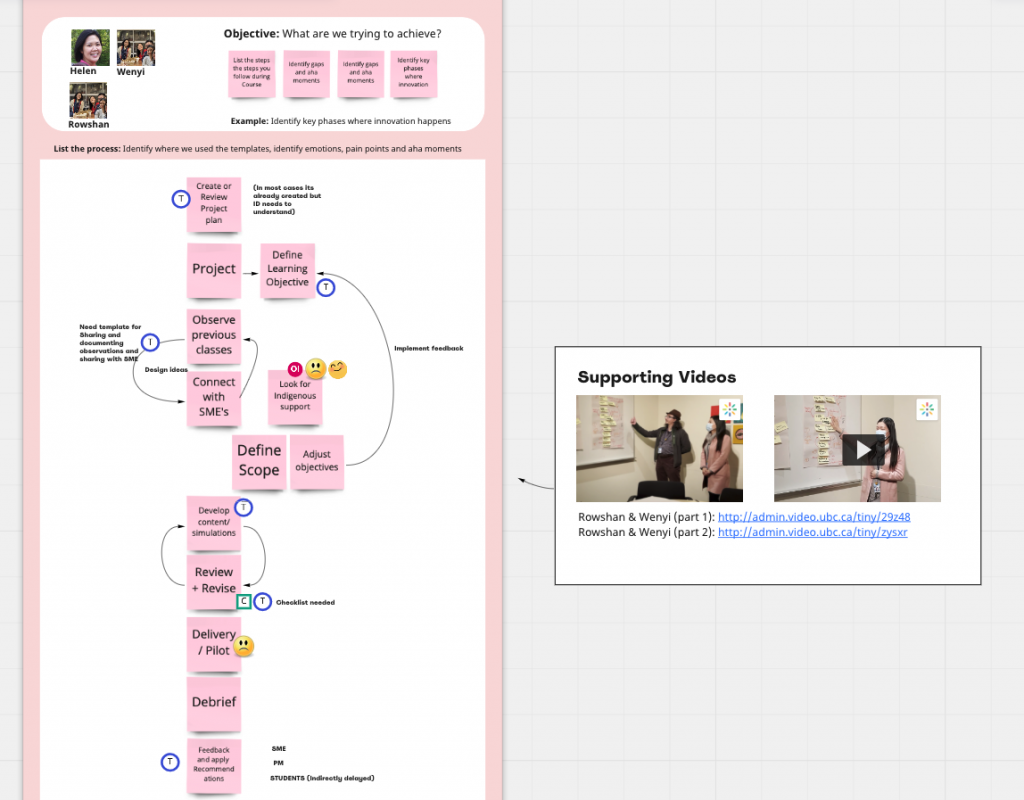Kavita George
Kavita is a Senior Web Specialist who specializes in UI/UX design at CTLI.

Creating a Service Blueprint for Course Design

Recently we ran a “service blueprint” exercise to outline an overview on how we build Course planning at JIBC and how we deliver end to end experiences. The purpose of this activity was to help clarify how we work with clients at JIBC and how we can best contribute as course developers.
So, what is a service blueprint?
Neilson Norman defines it as “A framework to analyze and improve an existing service.”
A service blueprint for course planning is an activity to organize and map out relationships between different roles, departments, and functions. Our overarching goal for blueprinting the course planning was to directly improve our clients’ experience and indirectly, the student experience. Learn more about the benefits of Service Blueprint at Neislon Norman group.
The need
As we started to plan our latest issue around course planning, design and development, we were curious to learn what and how we do course planning at JIBC. What is our current process? How do we evaluate our services? What does a successful process look like? We wanted to go back to basics by mapping out a blueprint that would give us an overview of all the players involved and allow us to have a shared understanding of that process. This way we hope to be better able to articulate our course planning services and attendant activities, like cost estimation, new project planning, and onboarding new employees among others. Many of us have been doing this unique work for several years, so it is good to compare perspectives as a way to reaching a departmental outlook on the process.
Our scope
At CTLI since our vision is to support instructors and program areas as they plan for their courses and prep for teaching. While course design often identifies a straightforward linear process from start to finish for the development of a program, course, or individual chunk of content, we recognize that we do not always follow this process so thoroughly or in a straight line. There are lots of jumping and jumping off points. Our clients (program staff/instructors) may come to us having started considerable work on their own. Any course development team may have a different variety of skills on offer. Priorities and decisions may change somewhere along the way. The starting point of our involvement is not always the starting point of the official process. When someone comes to CTLI to ask for help with the development of a course, our response is invariable an enthusiastic YES. But how we help depends upon what’s needed and where we find ourselves in the grand scheme of development. We wanted to fill in all aspects of course design and development across various practices and departments.
Part 1: The Hub Hackathons – Brainstorming through open, interactive conversations
We gathered Instructional designers from Police Academy and Centre for Teaching and Learning for the Hub hackathon. Each group outlined their scenarios and task flow/processes. Similarly, we also gathered the video producers and web specialists to share their own course planning process. The idea was to see what the course development process looked like from different perspectives by those who play a crucial role.


As we opened to meaningful conversations and brainstormed through many possible scenarios and tasks flows, we learnt a lot about the existing process and what good practice looks like. Along the way, we were able to identify:
- a-ha moments and pain points
- opportunities where gaps needed to be filled
- templates, tools and assets
- phases to incorporate those big ideas that matter to us as educators – Universal design, Equity, Diversity, and Inclusion, Work Integrated Learning, Indigenization and Open Education to name a few
- any areas of improvements and innovation
 Part 2: Building a Service Blueprint
Part 2: Building a Service Blueprint
We brought teams together for the Part 2 of the exercise to collaborate on building the basics through blueprint. In our Service Blueprint tool designed by Neilson Norman group, we started with customer journey and move down the swim lanes to Frontstage, Backstage action and finally added time, support process and evidence. Towards the end we added insight keys for teaching ideas to be incorporated.
Insights are important
The knowledge and information from this exercise, and research are valuable. Through this discovery process we learnt about ourselves; how we work and how each one of us added value. We used this knowledge to build bite sized insights that will help us make informed decisions in the future.


What’s next?
Having done this exercise, we have planned on next steps and where we want to go. Our mini team identified the goals for course planning, developed a solid understanding of ideal process, discovered the need for tools and templates and are now implementing and finalizing a guide that will help our program areas and instructors in course planning.
 Would you like to go through this process to help us identify how CTLI can most effectively work with you in the program areas? Please contact us and let’s discuss how to move forward: ctli@jibc.ca (subject line: let’s talk course development!).
Would you like to go through this process to help us identify how CTLI can most effectively work with you in the program areas? Please contact us and let’s discuss how to move forward: ctli@jibc.ca (subject line: let’s talk course development!).




